Today's post is courtesy of Ilana Winter, our Temp. Assistant Registrar. In this post, Ilana describes the process of crating our beloved Alexander McQueen Peacock dress for travel to the Modern Love exhibit in Bendigo, Australia. Read on for a wonderful overview of this fascinating, labor-intensive project.
**********
Approximately 7,937 miles lie between the FIDM Museum in Los Angeles and the Bendigo Art Gallery in Bendigo, Australia. That distance equates to roughly 132,283 football fields, a 16 1/2-hour flight, and about half a million gummy bears laid out head-to-toe. Transporting objects from our museum to other institutions always
requires intricate packing techniques to ensure the pieces’ safety. Our upcoming collaborative exhibition with the Bendigo Art Gallery, Modern Love: Fashion Visionaries from the FIDM Museum LA, will display nearly a hundred of our most exquisite contemporary objects. Considering how far the extraordinary (and also delicate) objects had to travel, the packing process
was remarkable. One object that went to Australia is the Alexander McQueen
Peacock dress from his Fall/Winter 2008-2009 collection. Here’s the story about how our piece went from “The Girl Who Lived in a Tree” to “The Girl Who Flew in a Crate.”
McQueen’s Peacock dress is a stunning example of his craftsmanship, creativity, and consistent nods to the United Kingdom’s rich history. Inspired by British Colonialism, the Indian Empire, and both Queen Victoria and Queen Elizabeth, the dress’s sculptured ruffles and confronted peacock lace motif stood out as a showstopper when it walked down the runway. To better understand the design, check out our previous post on the gown. The dress, which we commissioned from the Alexander McQueen atelier, was constructed on a Schlappi mannequin. Because the piece is permanently dressed on the mannequin, we had to pack it in a special way.
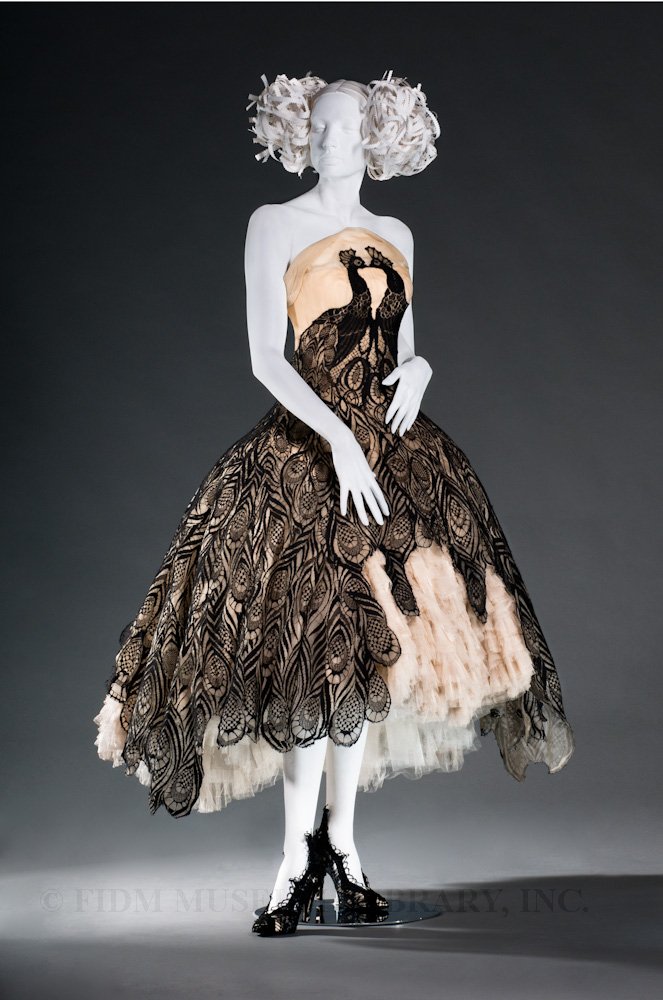 Evening dress
Evening dress
Fall/Winter 2008-9
Commissioned 2010
Alexander McQueen
Museum Commission
Funds provided by Karen Coombs-Jordan
2010.5.73
Comparing our packing technique to a commercial aircraft, we had Economy, Business, and First Class seating. The majority of our objects were in Economy class, which meant they were packed into our standard-sized boxes. A few objects required Business class, or, rather, custom-made boxes that had more voluminous dimensions. Both Economy and Business class (i.e. all the boxes) were packed into crates to fly to Bendigo. However, our lovely McQueen Peacock dress, or Lady McQueen as I like to personify her, did not fit in any box and required a little room to stretch her legs. And thus she had to travel First Class in her own custom-built crate.
To prepare for the long journey to Bendigo, we had to make sure Lady McQueen would travel comfortably; nothing could happen to her dress. This required carefully building volume between the layers of her dress. By placing sheets of tissue between her petticoat, ruffled skirt, and lace overlay, we created additional padding that provided protection in case she were to come into contact with the walls of the crate. To further protect the dress, we removed the mannequin’s arms so they would not press down and possibly induce damage. Sheets of tyvek (an archival material that feels like a plastic tablecloth) were then wrapped around Lady McQueen’s dress and secured with twill tape. We also wrapped her prop shoes with tissue and tyvek for extra
protection.
 Museum Registrar Meghan Grossman Hansen inspects the preliminary packing.
Museum Registrar Meghan Grossman Hansen inspects the preliminary packing.
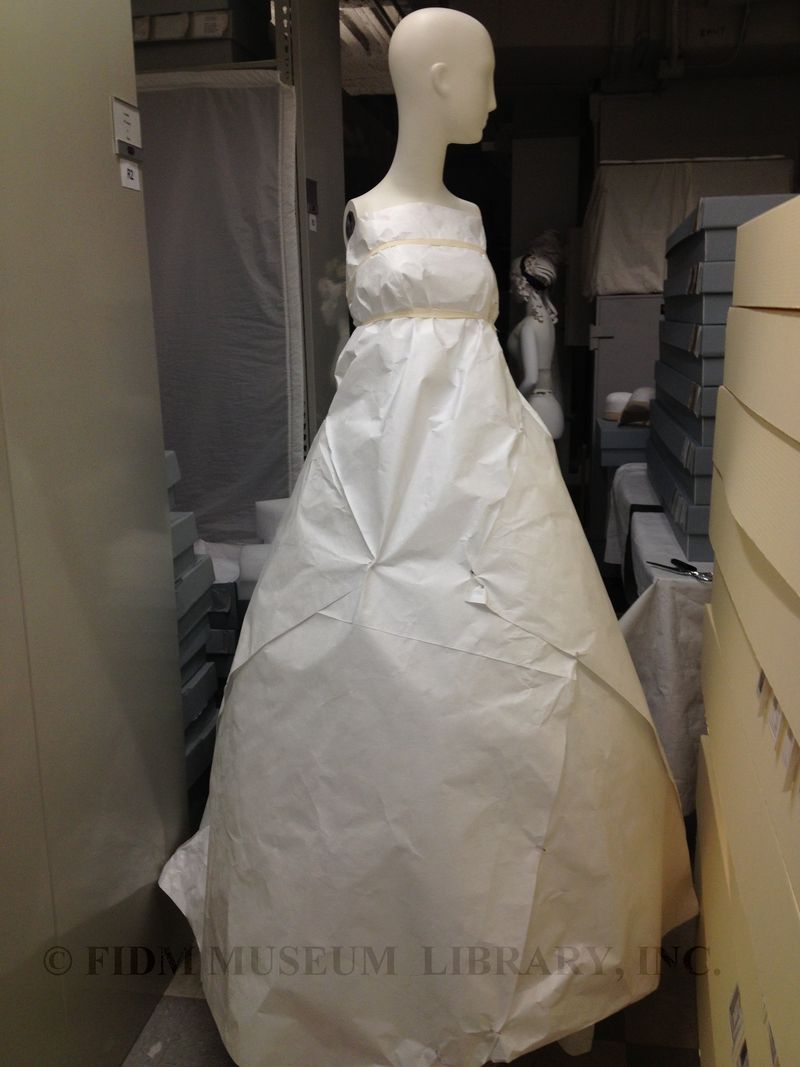 Lady McQueen ready to fly First Class.
Lady McQueen ready to fly First Class.
The U.S. Art crating department fitted Lady McQueen’s crate onsite at the FIDM Museum. This method of custom crating requires great skill, and produces an intricate, form-fitting art carrier that is practically a work of art itself. The step-by-step process starts with a general measurement of how much space the object (in this case, Lady McQueen) takes up in the empty crate.
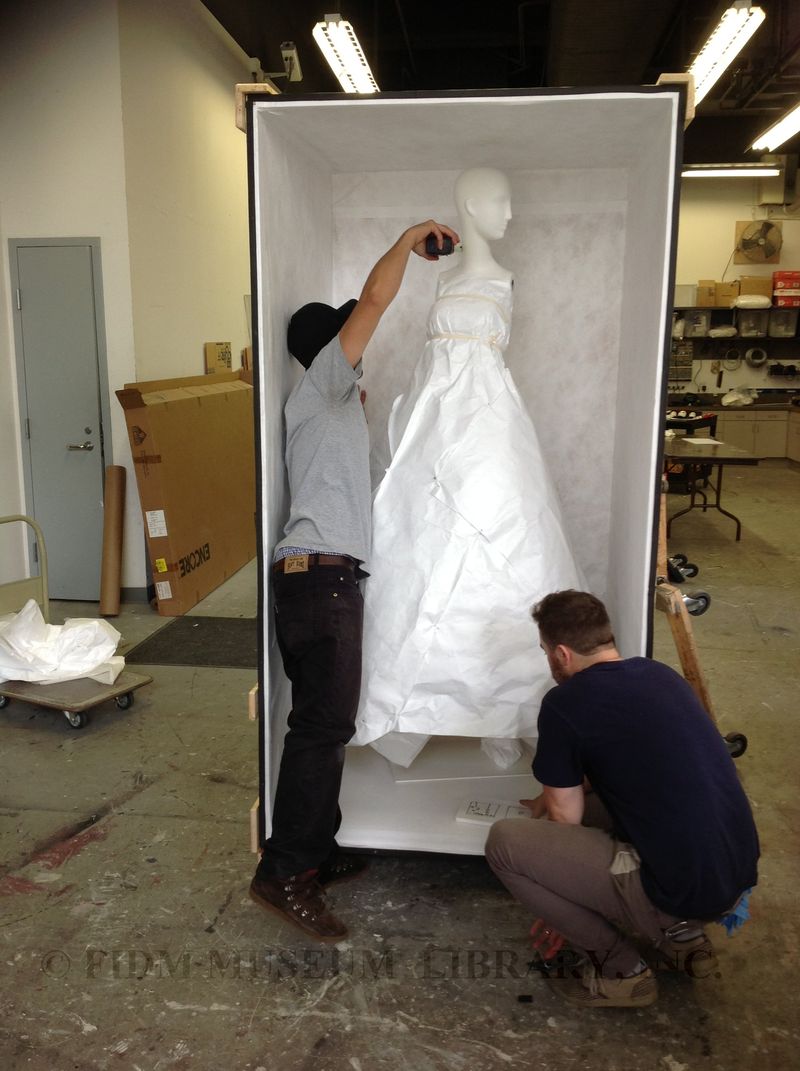 Two members of the U.S. Art crating department takes measurements of the McQueen Peacock dress inside the empty crate.
Two members of the U.S. Art crating department takes measurements of the McQueen Peacock dress inside the empty crate.
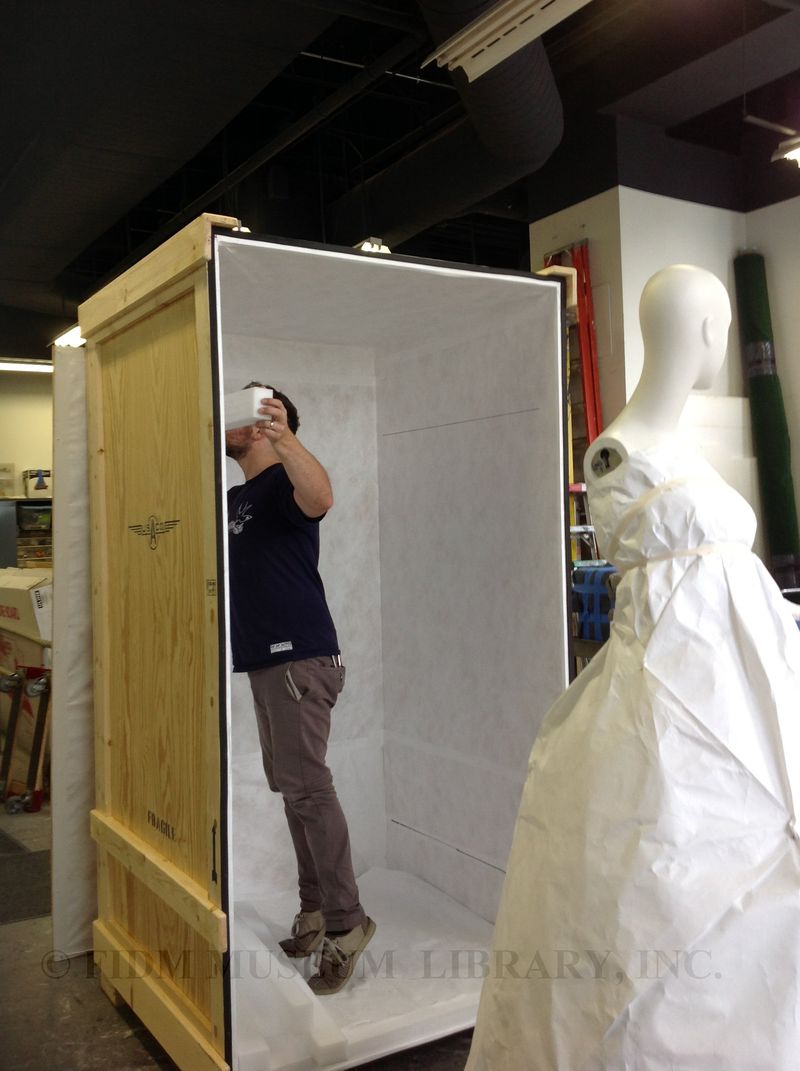 Ethafoam strips are attached to the crate to make shelving tracks. The tracks are used to hold ethafoam “guillotines” that keep the object in place. Note that those in the crate stand on a sheet of tyvek to ensure the crate stays clean while it’s being customized; every detail is considered during this process.
Ethafoam strips are attached to the crate to make shelving tracks. The tracks are used to hold ethafoam “guillotines” that keep the object in place. Note that those in the crate stand on a sheet of tyvek to ensure the crate stays clean while it’s being customized; every detail is considered during this process.
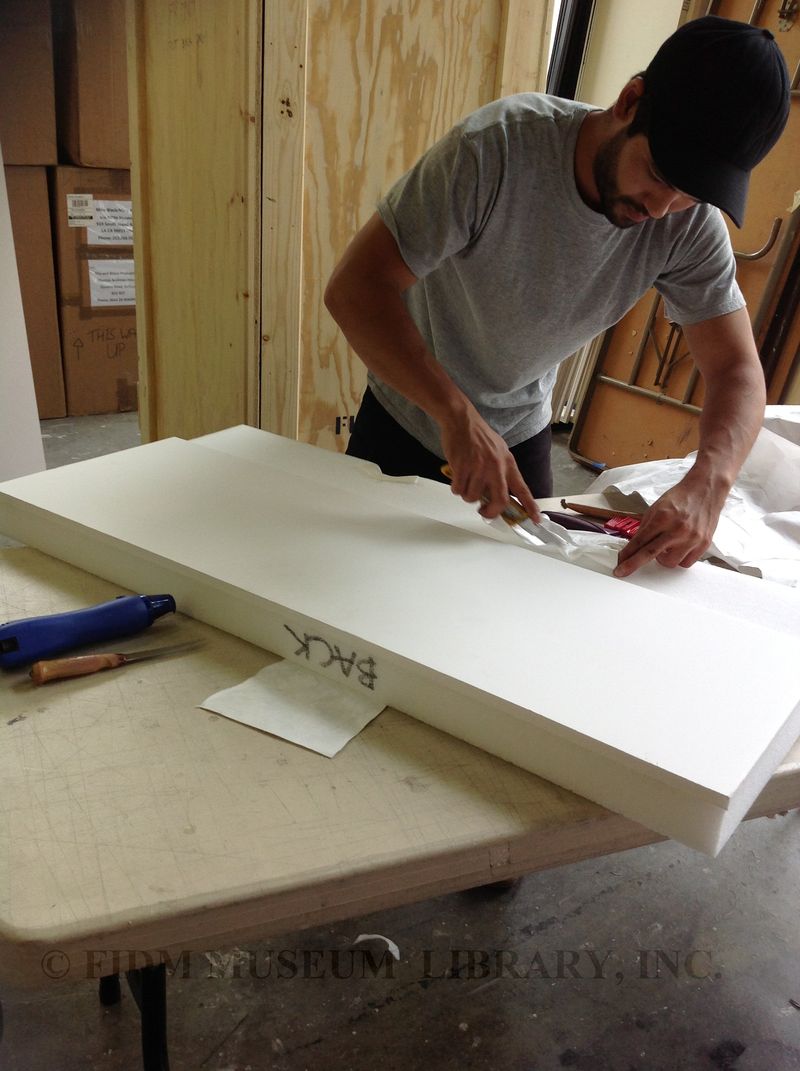 Half circles are cut into sheets of ethafoam to create guillotines. This set of guillotines, for example, is used to support the mannequin at the ankles; a second set of guillotines is also used for the mannequin’s neck. After attaching volara, an archival foam-like material, to create a cushion for the object on the guillotine, the half circles are covered with tyvek as additional
Half circles are cut into sheets of ethafoam to create guillotines. This set of guillotines, for example, is used to support the mannequin at the ankles; a second set of guillotines is also used for the mannequin’s neck. After attaching volara, an archival foam-like material, to create a cushion for the object on the guillotine, the half circles are covered with tyvek as additional
protection.
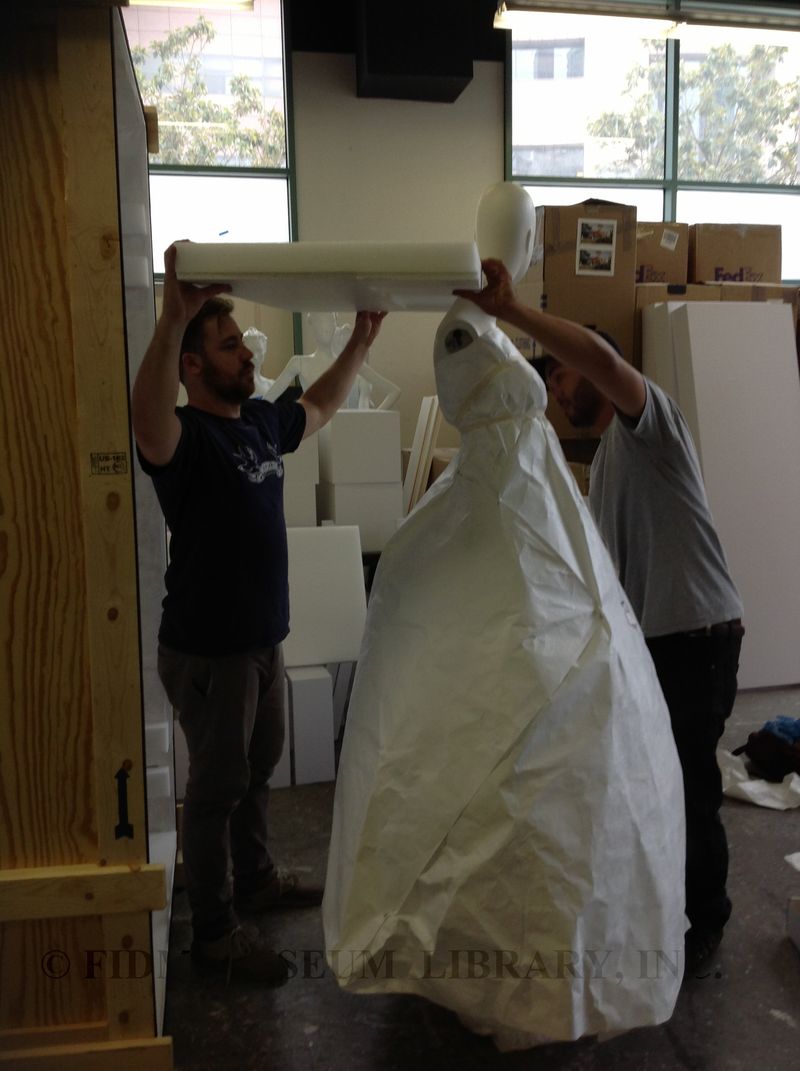 Lady McQueen has a fitting for her neck guillotine. Once the guillotines are finished, they are slid into the tracks to hold the mannequin
Lady McQueen has a fitting for her neck guillotine. Once the guillotines are finished, they are slid into the tracks to hold the mannequin
in place during travel.
 The mannequin’s head is firmly secured by the guillotines around her neck.
The mannequin’s head is firmly secured by the guillotines around her neck.
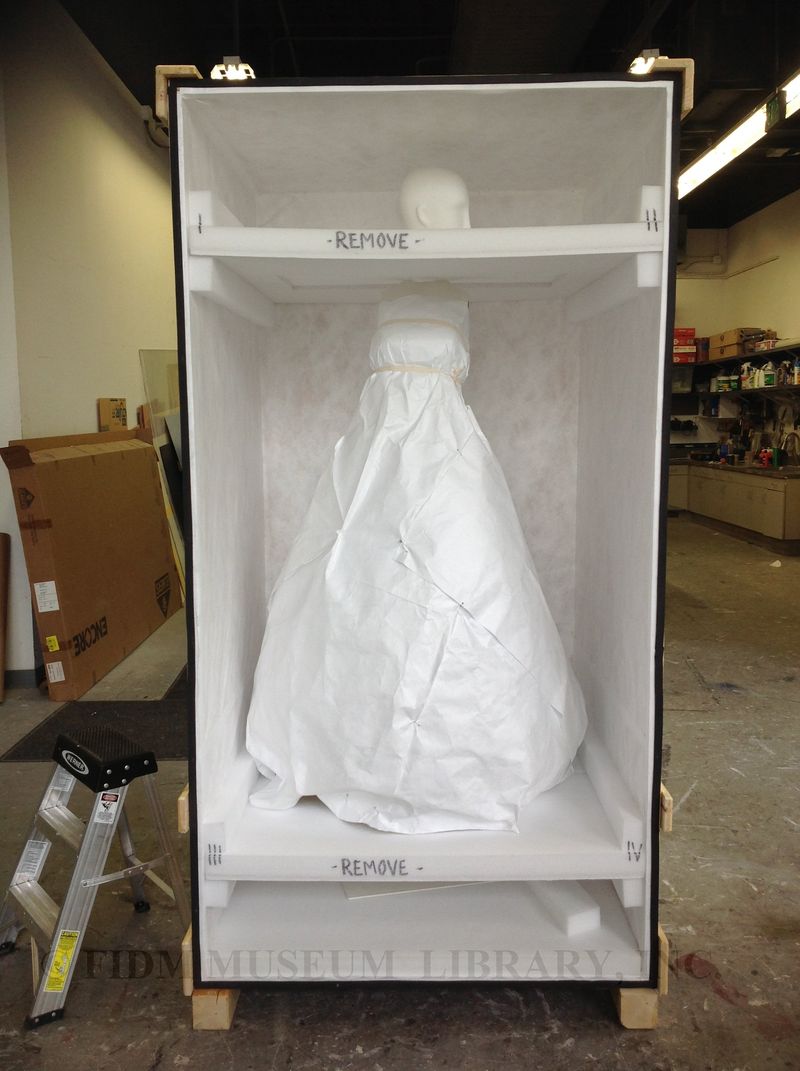 Lady McQueen is ready for her First Class flight to Bendigo.
Lady McQueen is ready for her First Class flight to Bendigo.
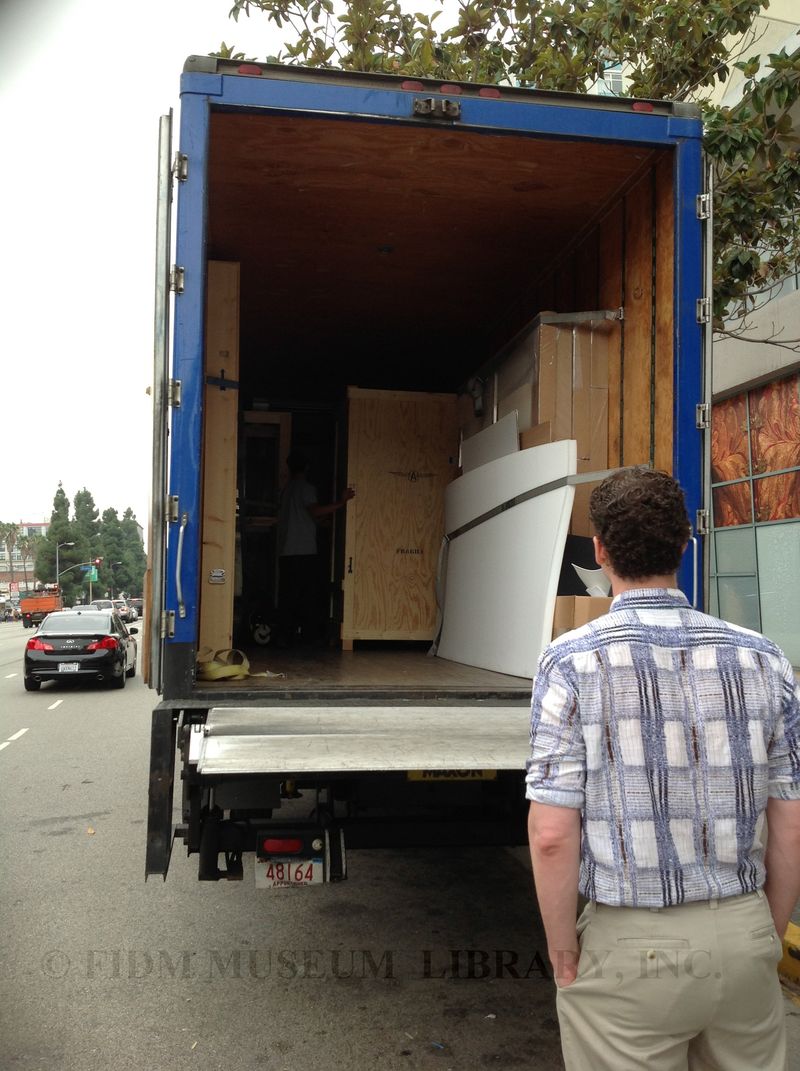 Museum Curator Kevin Jones says, “See you later,” to the Peacock dress as she starts her journey to Bendigo Art Gallery. Kevin, Associate Curator Christina Johnson and Collections Manager Dani
Museum Curator Kevin Jones says, “See you later,” to the Peacock dress as she starts her journey to Bendigo Art Gallery. Kevin, Associate Curator Christina Johnson and Collections Manager Dani
Killam are currently in Bendigo installing Modern Love: Fashion Visionaries from the FIDM Museum LA, where they’ve reunited with Lady McQueen.
For the next few months, the Alexander McQueen Peacock dress will be on display at the Bendigo Art Gallery. Come February, Lady McQueen will fly back home to FIDM Museum, safe and sound thanks to her custom-built crate.


Erm, there are more than 140 football fields between FIDM & Bendigo Australia, there’s more like 132,283 of them!
I really cant wait to see this exhibition and some Alexander McQueen pieces in the flesh. I can’t thank FIDM and the Bendigo Art Gallery enough for putting on such an amazing show. These kinds of events make us Antipodeans feel less isolated from the rest of the world!
I only hope one day I can actually visit FIDM itself!
Would love to see a follow-up to your informative post. Are there photos of the unpacking at the destination location?
Glad you enjoyed this post!
This blog post, by a blogger who visited the exhibit, features photos of McQueen’s Peacock dress after it was unpacked: http://theperfectnose.wordpress.com/2013/10/18/modern-love-a-preview/
This short video features our staff unpacking objects for the Modern Love exhibit: http://video.bendigoweekly.com.au/i3br/modern-love-2/